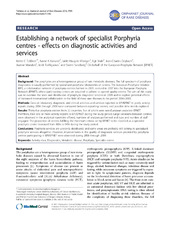| dc.contributor.author | Tollånes, Mette Christophersen | en_US |
| dc.contributor.author | Aarsand, Aasne K. | en_US |
| dc.contributor.author | Villanger, Jørild Haugen | en_US |
| dc.contributor.author | Støle, Egil | en_US |
| dc.contributor.author | Deybach, Jean-Charles | en_US |
| dc.contributor.author | Marsden, Joanne | en_US |
| dc.contributor.author | To-Figueras, Jordi | en_US |
| dc.contributor.author | Sandberg, Sverre | en_US |
| dc.contributor.author | European Porphyria Network | en_US |
| dc.date.accessioned | 2013-05-16T08:51:48Z | |
| dc.date.available | 2013-05-16T08:51:48Z | |
| dc.date.issued | 2012-12-10 | eng |
| dc.Published | Orphanet Journal of Rare Diseases 2012, 7:93 | eng |
| dc.identifier.issn | 1750-1172 | |
| dc.identifier.uri | https://hdl.handle.net/1956/6614 | |
| dc.description.abstract | Background: The porphyrias are a heterogeneous group of rare metabolic diseases. The full spectrum of porphyria diagnostics is usually performed by specialized porphyria laboratories or centres. The European Porphyria Initiative (EPI), a collaborative network of porphyria centres formed in 2001, evolved in 2007 into the European Porphyria Network (EPNET), where participating centres are required to adhere to agreed quality criteria. The aim of this study was to examine the state and distribution of porphyria diagnostic services in 2009 and to explore potential effects of increased international collaboration in the field of these rare diseases in the period 2006–2009. Methods: Data on laboratory, diagnostic and clinical activities and services reported to EPI/EPNET in yearly activity reports during 2006 through 2009 were compared between reporting centres, and possible time trends explored. Results: Thirty-five porphyria centres from 22 countries, five of which were non-European associate EPNET members, filed one or more activity reports to EPI/EPNET during the study period. Large variations between centres were observed in the analytical repertoire offered, numbers of analyses performed and type and number of staff engaged. The proportion of centres fulfilling the minimum criteria set by EPNET to be classified as a specialist porphyria centre increased from 80% to 94% during the study period. Conclusions: Porphyria services are unevenly distributed, and some areas are probably still lacking in specialized porphyria services altogether. However, improvements in the quality of diagnostic services provided by porphyria centres participating in EPI/EPNET were observed during 2006 through 2009. | en_US |
| dc.language.iso | eng | eng |
| dc.publisher | BioMed Central | eng |
| dc.rights | Attribution CC BY | eng |
| dc.rights.uri | http://creativecommons.org/licenses/by/2.0/ | eng |
| dc.subject | Activity data | eng |
| dc.subject | Diagnostics | eng |
| dc.subject | Metabolic disease | eng |
| dc.subject | Porphyria | eng |
| dc.title | Establishing a network of specialist Porphyria centres - effects on diagnostic activities and services | en_US |
| dc.type | Peer reviewed | |
| dc.type | Journal article | |
| dc.description.version | publishedVersion | en_US |
| dc.rights.holder | Copyright 2012 Tollånes et al.; licensee BioMed Central Ltd. | |
| dc.identifier.doi | https://doi.org/10.1186/1750-1172-7-93 | |
| dc.identifier.cristin | 1009129 | |
| dc.source.journal | Orphanet Journal of Rare Diseases | |
| dc.source.40 | 7 | |
| dc.source.14 | 93 | |

